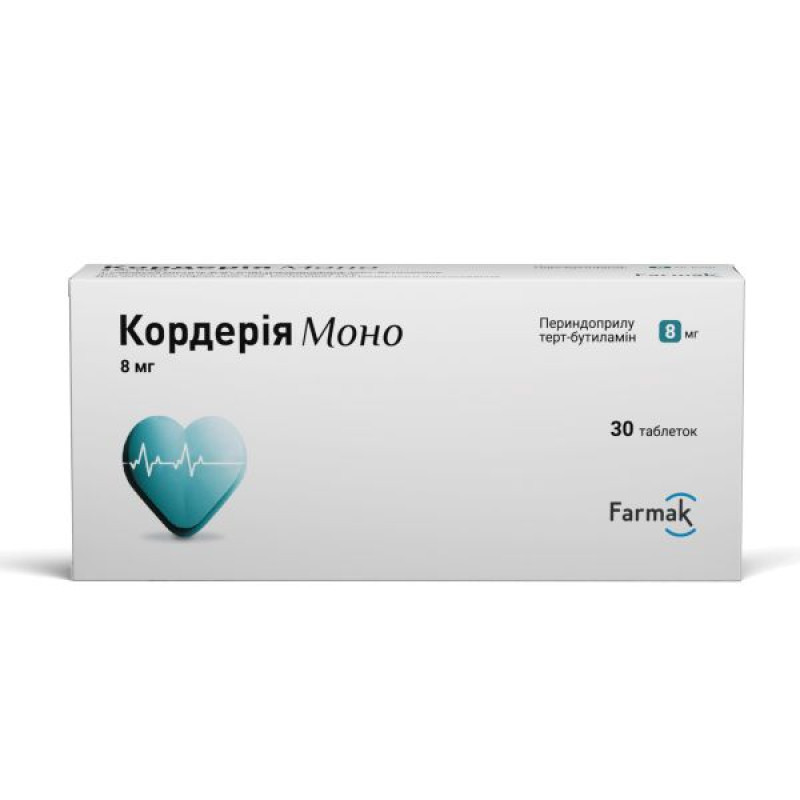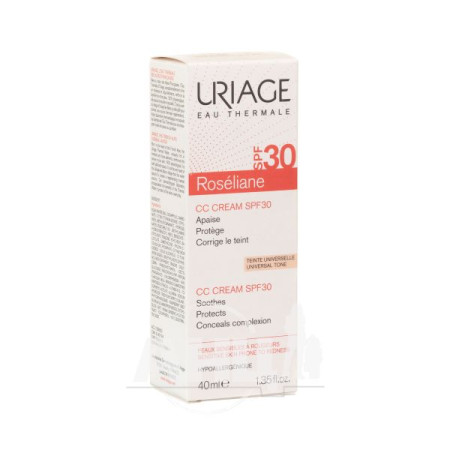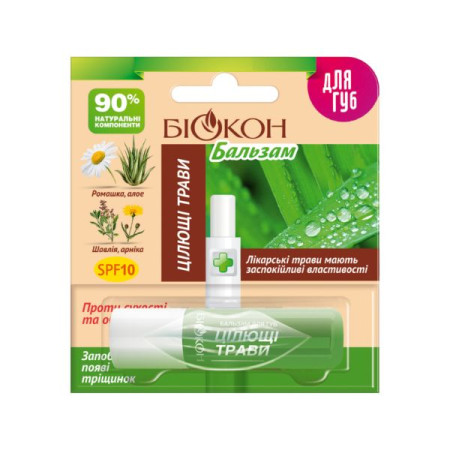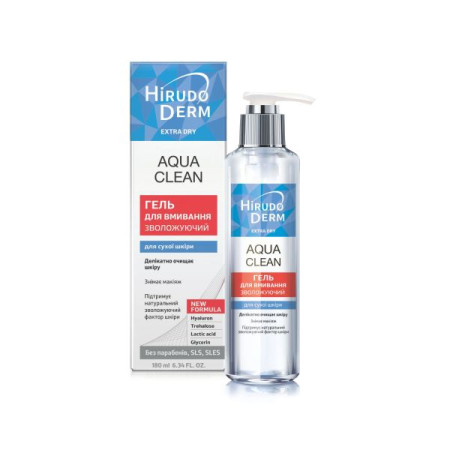Corderia Mono tablets 8 mg blister No. 30
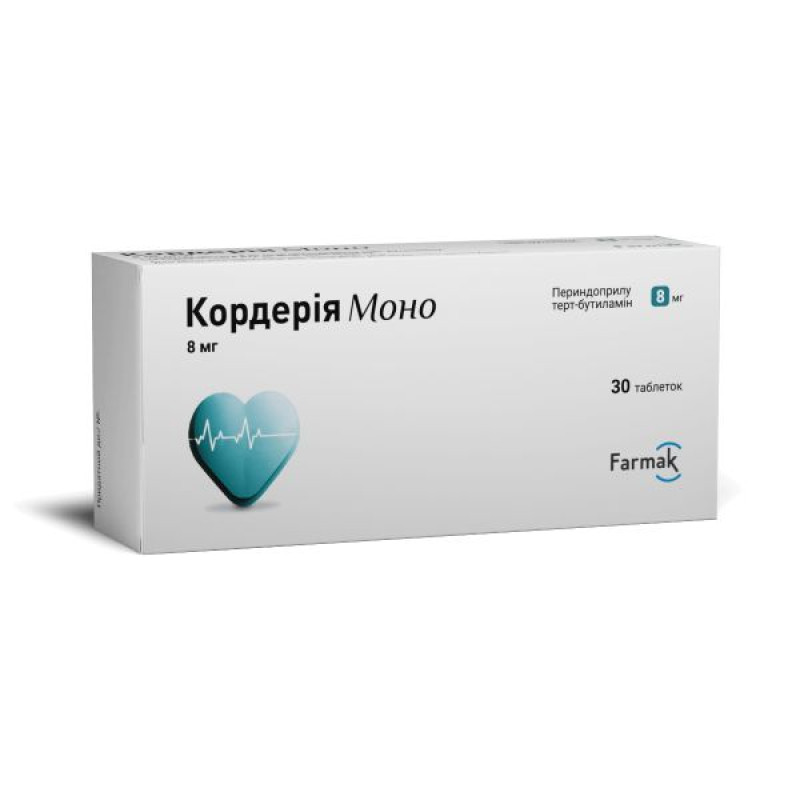
Instructions Corderia Mono tablets 8 mg blister No. 30
Composition
active ingredient: perindopril;
1 tablet contains 4 mg perindopril tert-butylamine, equivalent to 3.338 mg perindopril
or 8 mg perindopril tert-butylamine, equivalent to 6.676 mg perindopril;
Excipients: lactose monohydrate; microcrystalline cellulose; colloidal anhydrous silicon dioxide; magnesium stearate.
Dosage form
Pills.
Main physicochemical properties: round biconvex tablets from white to almost white in color.
Pharmacotherapeutic group: Cardiovascular agents: Angiotensin-converting enzyme (ACE) inhibitors, monocomponent.
Perindopril. ATX code C09A A04.
Pharmacological properties
Pharmacodynamics.
Perindopril is an inhibitor of the enzyme that converts angiotensin I to angiotensin II (angiotensin-converting enzyme (ACE)). The converting enzyme, or kinase, is an exopeptidase that enables the conversion of angiotensin I to the vasoconstrictor angiotensin II and also causes the breakdown of the vasodilator bradykinin to an inactive heptapeptide. Inhibition of ACE leads to a decrease in the concentration of angiotensin II in the blood plasma, which increases plasma renin activity (by inhibiting the negative feedback on renin release) and reduces aldosterone secretion. Since ACE inactivates bradykinin, inhibition of ACE also leads to an increase in the activity of the circulating and local kallikrein-kinin system (and thus also leads to activation of the prostaglandin system). This mechanism of action is responsible for the blood pressure lowering effect of ACE inhibitors and is partly responsible for some of their side effects (e.g., cough).
Perindopril tert-butylamine acts through its active metabolite, perindoprilat. Other metabolites do not demonstrate activity in inhibiting ACE under experimental conditions.
Arterial hypertension.
Perindopril effectively lowers blood pressure in all degrees of arterial hypertension: mild, moderate and severe; a decrease in systolic and diastolic blood pressure is observed both in the supine and standing positions.
Perindopril reduces peripheral vascular resistance, which leads to a decrease in blood pressure. As a result, peripheral blood flow increases without affecting heart rate.
Typically, renal blood flow also increases, while glomerular filtration rate (GFR) is usually unchanged.
The maximum antihypertensive effect develops 4–6 hours after a single dose and persists for at least 24 hours: the T/P ratio (trough/peak – minimum efficacy/maximum efficacy during the day) of perindopril is 87–100%.
Blood pressure decreases rapidly. In patients who respond to treatment, blood pressure normalization occurs within a month and is maintained without the occurrence of tachyphylaxis.
There is no withdrawal effect when perindopril is discontinued.
Perindopril reduces left ventricular hypertrophy.
Clinical studies have shown that perindopril has vasodilating properties. It improves the elasticity of large arteries and reduces the ratio of wall thickness to lumen for small arteries.
Add-on therapy with a thiazide diuretic has a synergistic effect. The combination of an ACE inhibitor and a thiazide diuretic also reduces the risk of diuretic-induced hypokalemia.
Heart failure.
Perindopril tert-butylamine reduces heart work by reducing pre- and afterload on the heart.
Studies in patients with heart failure have demonstrated:
- decrease in filling pressure of the right and left ventricles;
- reduction of systemic peripheral resistance;
- increase in cardiac index and improvement in cardiac output;
In comparative studies, the initial administration of 2 mg perindopril to patients with mild to moderate heart failure was not associated with any significant reduction in blood pressure compared with placebo.
Patients with a history of cerebrovascular disease.
The multicenter international double-blind randomized placebo-controlled PROGRESS study determined the benefits of 4 years of treatment with perindopril (as monotherapy or in combination with indapamide) in preventing recurrent stroke in patients with a history of cerebrovascular disease.
The primary endpoint was stroke.
After 2 weeks (run-in period) of perindopril tert-butylamine 2 mg once daily and a further 2 weeks of 4 mg once daily, 6105 patients were randomised to either placebo (n=3054) or perindopril tert-butylamine 4 mg monotherapy or in combination with indapamide (n=3051). Indapamide was added to patients who had indications for diuretics and no contraindications to diuretics.
All patients who participated in the study had a history of cerebrovascular disease (stroke or transient ischemic attack) within the past 5 years. Blood pressure was not a criterion for inclusion in the study: 2916 patients had hypertension, 3189 patients had normal blood pressure.
After 3.9 years (on average) of follow-up, systolic/diastolic blood pressure decreased by an average of 9.0/4.0 mm Hg and the risk of recurrent strokes (both ischemic and hemorrhagic) was significantly reduced by 28% (95% CI [17;38], p1% compared to 13.8%).
There was also a significant reduction in the risk of:
- fatal or disabling stroke (4% compared to 5.9%, corresponding to a 33% risk reduction);
- total major cardiovascular events, consisting of cardiovascular death, non-fatal myocardial infarction and non-fatal stroke (15% compared to 19.8%, corresponding to a risk reduction of 26%);
- dementia resulting from stroke (1.4% compared to 2.1%, corresponding to a 34% risk reduction), and severe cognitive impairment resulting from stroke (1.6% compared to 2.8%, corresponding to a 45% risk reduction);
- major coronary events, including non-fatal myocardial infarction or death due to coronary heart disease (3.8% versus 5%, corresponding to a 26% risk reduction).
These therapeutic benefits were observed in patients regardless of the presence/absence of arterial hypertension, regardless of age, sex, type of stroke or presence of diabetes. The results of the PROGRESS study showed that after 5 years of treatment, one stroke in every 23 patients and one major cardiovascular event in every 18 patients could be avoided.
Patients with stable coronary artery disease.
EUROPA is an international multicenter, randomized, double-blind, placebo-controlled clinical trial that lasted 4 years. 12,218 patients aged 18 years and older were randomized to groups: 6,110 patients received 8 mg perindopril tert-butylamine and 6,108 patients received placebo. The study included patients with confirmed ischemic heart disease and without clinical symptoms of heart failure. Overall, 90% of patients had a history of myocardial infarction and/or revascularization surgery. Most patients in the study received perindopril in addition to standard therapy: antiplatelet agents, lipid-lowering drugs and β-blockers.
The primary efficacy endpoint was the composite of cardiovascular mortality, non-fatal myocardial infarction and/or cardiac arrest with subsequent successful resuscitation. Treatment with perindopril 8 mg once daily resulted in a significant absolute reduction in the primary endpoint of 1.9% (relative risk reduction of 20%, 95% CI [9.4, 28.6] – p
In patients with a history of myocardial infarction and/or revascularization, there was an absolute reduction of 2.2% in the primary endpoint, corresponding to a relative risk reduction of 22.4% (95% CI [12.0, 31.6] – p
Application to children.
The safety and efficacy of perindopril in children and adolescents under 18 years of age have not been established.
In an open-label, non-comparative clinical study, 62 children aged 2 to 15 years with a glomerular filtration rate > 30 ml/min/1.73 m2 were given perindopril at a mean dose of 0.07 mg/kg. The dose was titrated individually, up to a maximum of 0.135 mg/kg/day, depending on the patient profile and blood pressure response to treatment. 59 patients were enrolled in the study for 3 months, 36 patients continued treatment for at least 24 months (mean study duration 44 months). Systolic and diastolic blood pressure remained stable (from baseline to last visit) in patients previously treated with other antihypertensive drugs and decreased in patients previously untreated. More than 75% of the children had systolic and diastolic blood pressure below the 95th percentile at their last study visit. The safety profile in children was consistent with the known safety profile of perindopril.
Pharmacokinetics.
Absorption.
After oral administration, perindopril is rapidly absorbed, with peak plasma concentrations occurring within 1 hour. The plasma half-life of perindopril is 1 hour.
Perindopril is a prodrug. 27% of the total amount of perindopril taken is determined in the blood in the form of the active metabolite - perindoprilat. In addition to the active metabolite - perindoprilat, the drug forms 5 metabolites that are inactive. The maximum concentration of perindoprilat in the blood plasma is reached 3-4 hours after administration.
Food intake reduces the conversion of perindopril to perindoprilat, thus reducing its bioavailability, therefore the daily dose of perindopril tert-butylamine is recommended to be taken once in the morning before meals.
There is a linear relationship between the dose of perindopril and its concentration in blood plasma.
Distribution.
Breeding.
Perindoprilat is excreted in the urine. The terminal half-life of the unbound fraction is approximately 17 hours. Steady-state plasma concentrations are reached within 4 days of initiation of treatment.
Special patient groups.
The elimination of perindoprilat is slowed in elderly patients and in patients with heart or renal failure. It is recommended to select the dose for patients with renal failure, taking into account the degree of insufficiency (creatinine clearance).
Dialysis clearance of perindoprilat is 70 ml/min.
The kinetics of perindopril are altered in patients with cirrhosis: the hepatic clearance of perindopril is halved. However, the amount of perindoprilat formed is not reduced. Therefore, no dose adjustment is required in such patients.
Clinical characteristics.
Indication
- Arterial hypertension.
- Heart failure.
- Prevention of recurrent stroke in patients with cerebrovascular disease.
- Prevention of cardiovascular complications in patients with documented stable ischemic heart disease.
Long-term treatment reduces the risk of myocardial infarction and heart failure (according to the results of the EUROPA study).
Contraindication
- Hypersensitivity to perindopril or to any of the excipients, or to any other ACE inhibitor;
- history of angioedema associated with previous treatment with an ACE inhibitor (see section "Special warnings and precautions for use");
- idiopathic or hereditary angioedema;
- simultaneous use with drugs containing the active substance aliskiren in patients with diabetes mellitus or with impaired renal function (glomerular filtration rate 2) (see section "Interaction with other medicinal products and other types of interactions");
- pregnant women or women planning to become pregnant (see section "Use during pregnancy or breastfeeding");
- simultaneous use with sacubitril/valsartan. The use of Corderia Mono should not be started earlier than 36 hours after taking the last dose of sacubitril/valsartan (see sections “Special instructions for use” and “Interaction with other medicinal products and other types of interactions”);
- extracorporeal treatment methods that lead to contact of blood with negatively charged surfaces (see section "Interaction with other medicinal products and other types of interactions");
- significant bilateral renal artery stenosis or stenosis of the artery to a single functioning kidney (see section "Special warnings and precautions for use").
Interaction with other medicinal products and other types of interactions
Clinical trial data suggest that dual blockade of the renin-angiotensin-aldosterone system (RAAS) through the concomitant use of ACE inhibitors, angiotensin II receptor blockers or aliskiren is associated with a higher incidence of adverse reactions such as hypotension, hyperkalaemia and decreased renal function (including acute renal failure) compared to the use of a single RAAS-acting agent (see sections 4.3 and 4.4).
Medicines that increase the risk of developing angioedema
Concomitant use of ACE inhibitors with sacubitril/valsartan is contraindicated as it increases the risk of angioedema (see sections 4.3 and 4.4). Sacubitril/valsartan should not be initiated earlier than 36 hours after the last dose of perindopril. Perindopril should not be initiated earlier than 36 hours after the last dose of sacubitril/valsartan (see sections 4.3 and 4.4).
Concomitant use of ACE inhibitors with racecadotril, mTOR inhibitors (e.g. sirolimus, everolimus, temsirolimus) and gliptins (e.g. linagliptin, saxagliptin, sitagliptin, vildagliptin) may lead to an increased risk of angioedema (see section 4.4).
Drugs that cause hyperkalemia.
Serum potassium levels are usually within normal limits, but hyperkalaemia may occur in some patients taking Corderia Mono. Some medicinal products or therapeutic classes of medicinal products may cause hyperkalaemia, including aliskiren, potassium salts, potassium-sparing diuretics (e.g. spironolactone, triamterene or amiloride), ACE inhibitors, angiotensin II receptor antagonists, non-steroidal anti-inflammatory drugs (NSAIDs), heparins, immunosuppressants such as ciclosporin or tacrolimus, trimethoprim and co-trimoxazole (trimethoprim/sulfamethoxazole), as trimethoprim acts as a potassium-sparing diuretic, similar to amiloride. Concomitant use of these medicinal products increases the risk of hyperkalaemia. Therefore, the concomitant use of Corderia Mono with the above-mentioned drugs is not recommended. If concomitant use of these substances is necessary, they should be used with caution and serum potassium should be monitored frequently.
Aliskiren: In patients with diabetes mellitus or patients with impaired renal function, the risk of hyperkalemia, worsening of renal function, and cardiovascular morbidity and mortality is increased.
Extracorporeal treatments that result in contact of blood with negatively charged surfaces, such as high-flux dialysis or haemofiltration membranes (e.g. polyacrylamide membranes) and low-density lipoprotein apheresis with dextran sulphate, may increase the risk of severe anaphylactoid reactions (see section 4.3). If such treatment is necessary, consideration should be given to using a different type of dialysis membrane or a different class of antihypertensive medicinal product.
Concomitant use is not recommended (see section "Special precautions for use").
Aliskiren: in all other patients, as well as in patients with diabetes mellitus or patients with impaired renal function, the risk of hyperkalemia, worsening of renal function and cardiovascular morbidity and mortality is increased.
Concomitant use of an ACE inhibitor and an angiotensin receptor blocker
According to the literature, in patients with established atherosclerosis, heart failure or diabetes mellitus with target organ damage, the simultaneous use of ACE inhibitors and angiotensin receptor blockers was accompanied by an increased incidence of arterial hypotension, syncope, hyperkalemia and deterioration of renal function (including acute renal failure) compared with monotherapy with drugs that affect the renin-angiotensin-aldosterone system. The use of dual blockade (i.e. the combination of an ACE inhibitor with angiotensin II receptor antagonists) is possible only in individual cases, subject to careful monitoring of renal function, potassium levels and blood pressure.
Estramustine: increased risk of adverse reactions such as angioedema.
Potassium-sparing diuretics (e.g. triamterene, amiloride, etc.), potassium salts: hyperkalemia (potentially fatal), especially in patients with impaired renal function (additive hyperkalemic effect). These drugs are not recommended for concomitant use with perindopril (see section "Special warnings and precautions for use"). However, if concomitant use of these substances is necessary, they should be used with caution and serum potassium should be monitored frequently. Regarding the use of spironolactone in heart failure, see section "Concomitant use requiring special attention".
Lithium. Reversible increases in serum lithium concentrations and toxicity have been reported with the concomitant use of ACE inhibitors and lithium preparations. The use of perindopril with lithium preparations is not recommended. If such use is necessary, careful monitoring of serum lithium levels is essential (see section 4.4).
Concomitant use requiring special attention.
Antidiabetic agents (insulin, oral hypoglycemic agents).
Epidemiological studies have shown that concomitant use of ACE inhibitors and antidiabetic agents (insulin, oral hypoglycaemic agents) may lead to an increased blood sugar lowering effect with a risk of hypoglycaemia. This is more likely to occur during the first weeks of combined treatment and in patients with renal impairment.
Baclofen enhances the antihypertensive effect. Blood pressure should be monitored and, if necessary, the dose of the antihypertensive agent should be adjusted.
Potassium-sparing diuretics (eplerenone, spironolactone). When eplerenone or spironolactone at doses of 12.5 mg to 50 mg per day are used concomitantly with low-dose ACE inhibitors in patients with heart failure of New York Heart Association (NYHA) functional classes II-IV and ejection fraction who have previously received ACE inhibitors and loop diuretics, there is a risk of hyperkalemia (potentially fatal), especially if the recommendations for the appointment of such a combination are not followed. Before starting the use of such a combination, it is necessary to ensure the absence of hyperkalemia and impaired renal function. It is recommended to carefully monitor potassium and creatinine weekly during the first month of treatment and monthly thereafter.
Nonsteroidal anti-inflammatory drugs (NSAIDs), including acetylsalicylic acid ≥ 3 g/day. A reduction in the antihypertensive effect may occur when ACE inhibitors are used concomitantly with NSAIDs such as: acetylsalicylic acid at anti-inflammatory doses, COX-2 inhibitors, non-selective NSAIDs. Concomitant use of ACE inhibitors and NSAIDs may increase the risk of worsening renal function, including the possibility of acute renal failure, and an increase in serum potassium, especially in patients with a history of impaired renal function. This combination should be administered with caution, particularly in the elderly. Patients should be rehydrated and advised to monitor renal function after initiation of combination therapy and during subsequent treatment.
Concurrent use requiring attention.
Antihypertensives and vasodilators: Concomitant use of antihypertensives may increase the hypotensive effect of perindopril. Concomitant use with nitroglycerin and other nitrates or with other vasodilators may contribute to an additional decrease in blood pressure.
Concomitant use of some tricyclic antidepressants or antipsychotics or anesthetics with ACE inhibitors may lead to a further decrease in blood pressure (see section "Special warnings and precautions for use").
Sympathomimetics may weaken the antihypertensive effect of ACE inhibitors.
Gold: A nitrate-like reaction (symptoms include facial flushing, nausea, vomiting, and hypotension) has been reported rarely in patients receiving concomitant ACE inhibitors, including perindopril, and injectable gold (sodium aurothiomalate).
Application features
Stable coronary artery disease: If an episode of unstable angina (of any severity) occurs during the first month of treatment with perindopril, the risk/benefit ratio should be carefully weighed before deciding whether to continue therapy.
Hypotension. ACE inhibitors may cause a decrease in blood pressure. Symptomatic hypotension is less common in patients with uncomplicated hypertension and is more likely to occur in patients who are volume-depleted, on diuretics, on a salt-restricted diet, on dialysis, in patients with diarrhoea or vomiting, or in patients with severe renin-dependent hypertension (see sections 4.5 and 4.8). Symptomatic hypotension has been observed in patients with symptomatic heart failure, with or without concomitant renal insufficiency. Symptomatic hypotension is most likely to occur in patients with more severe heart failure, those receiving high doses of loop diuretics, those with hyponatremia or functional renal insufficiency. Patients at increased risk of symptomatic hypotension should be closely monitored during initiation of therapy and during dose titration (see sections 4.2 and 4.8). The same precautions apply to patients with ischemic heart disease or cerebrovascular disease, in whom an excessive decrease in blood pressure could result in myocardial infarction or stroke.
If hypotension occurs, the patient should be placed in the supine position and, if necessary, intravenously administered 0.9% (9 mg/ml) sodium chloride solution. Transient hypotension is not a contraindication to continued use of the drug, which can usually be used without any problems after volume restoration and blood pressure increase.
In some patients with congestive heart failure with normal or low blood pressure, perindopril tert-butylamine may cause an additional decrease in systemic blood pressure. This effect is expected and usually does not require discontinuation of the drug. If hypotension becomes symptomatic, it may be necessary to reduce the dose or discontinue the drug.
Aortic and mitral valve stenosis/hypertrophic cardiomyopathy: As with other ACE inhibitors, perindopril tert-butylamine should be administered with caution to patients with mitral valve stenosis or left ventricular outflow obstruction (aortic stenosis or hypertrophic cardiomyopathy).
In case of renal insufficiency (creatinine clearance "Method of administration and dosage"), and further - depending on the patient's response to treatment. Regular monitoring of potassium and creatinine is part of normal medical practice for such patients (see section "Adverse reactions").
In patients with symptomatic heart failure, hypotension occurring at the start of ACE inhibitors may lead to deterioration of renal function, in some cases with the development of acute renal failure, which is usually reversible.
In some patients with bilateral renal artery stenosis or stenosis of the artery to a solitary kidney, increases in blood urea and serum creatinine have been observed during treatment with ACE inhibitors, which usually return to normal after discontinuation of treatment. This is especially true in patients with renal insufficiency. In the presence of concomitant renovascular hypertension, the risk of severe hypotension and renal insufficiency increases. In such patients, treatment should be initiated under close medical supervision with low doses and with careful dose titration. In view of the above, diuretic treatment may contribute to the development of arterial hypotension, so they should be discontinued and renal function should be monitored during the first weeks of treatment with perindopril tert-butylamine.
In some hypertensive patients with no known renovascular disease prior to treatment, increases in blood urea and serum creatinine, usually minor and transient, have occurred, particularly when perindopril tert-butylamine has been administered concomitantly with a diuretic. However, this is more likely to occur in patients with pre-existing renal insufficiency. A dose reduction and/or discontinuation of the diuretic and/or perindopril tert-butylamine may be necessary.
Patients undergoing hemodialysis: Anaphylactoid reactions have been reported in patients receiving ACE inhibitors while undergoing hemodialysis using high-flux membranes. Such patients should be switched to a different type of dialysis membrane or to a different class of antihypertensive agent.
Patients after kidney transplantation: There is no experience with the administration of perindopril tert-butylamine to patients after a recent kidney transplantation.
Renovascular hypertension.
When ACE inhibitors are administered to patients with bilateral renal artery stenosis or stenosis of the artery to a single functioning kidney, there is an increased risk of hypotension and renal failure (see section 4.3). Diuretic therapy may be a beneficial factor. Loss of renal function may be manifested by minimal changes in serum creatinine levels even in patients with stenosis of the artery to a single kidney.
Hypersensitivity/angioedema.
Rare cases of angioedema of the face, extremities, lips, mucous membranes, tongue, glottis and/or larynx have been reported in patients receiving ACE inhibitors, including perindopril tert-butylamine (see section 4.8). This may occur at any time during treatment. In such cases, the drug should be discontinued immediately and the patient should be monitored until symptoms resolve. In those rare cases where the swelling is limited to the face and lips, the patient usually improves without treatment. Antihistamines may be useful in reducing symptoms.
Angioedema associated with laryngeal oedema may be fatal. In cases where the oedema involves the tongue, glottis or larynx causing airway obstruction, urgent emergency treatment is required, which may include administration of adrenaline and/or airway management. The patient should be closely monitored until symptoms have resolved and the condition has stabilised. Patients with a history of angioedema unrelated to ACE inhibitors are at increased risk of developing angioedema while taking ACE inhibitors (see section 4.3).
Concomitant use of perindopril with sacubitril/valsartan is contraindicated due to an increased risk of angioedema (see section 4.3). Sacubitril/valsartan should not be started until 36 hours after the last dose of perindopril. If treatment with sacubitril/valsartan is discontinued, perindopril should not be started until 36 hours after the last dose of sacubitril/valsartan (see sections 4.3 and 4.5).
Concomitant use of ACE inhibitors with neutral endopeptidase (NEP) inhibitors (e.g. racecadotril), mTOR inhibitors (e.g. sirolimus, everolimus, temsirolimus) and gliptins (e.g. linagliptin, saxagliptin, sitagliptin, vildagliptin) may lead to an increased risk of angioedema (e.g. swelling of the airways or tongue, with or without respiratory impairment) (see section 4.5). Caution should be exercised when initiating treatment with racecadotril, mTOR inhibitors (e.g. sirolimus, everolimus, temsirolimus) and gliptins (e.g. linagliptin, saxagliptin, sitagliptin, vildagliptin) in patients already taking ACE inhibitors.
Anaphylactoid reactions during low-density lipoprotein (LDL) plasmapheresis. Life-threatening anaphylactoid reactions have been reported rarely in patients receiving ACE inhibitors during low-density lipoprotein (LDL) plasmapheresis using dextran sulfate. Anaphylactoid reactions can be avoided by temporarily withholding ACE inhibitor therapy prior to each plasmapheresis.
Anaphylactoid reactions during desensitization therapy. Patients receiving ACE inhibitors during desensitization therapy (e.g., preparations containing bee venom) may experience life-threatening anaphylactoid reactions. These reactions can be avoided by temporarily discontinuing the ACE inhibitor, but the reactions may recur if provocation tests are performed carelessly.
Hepatic failure. Rarely, the use of ACE inhibitors has been associated with a syndrome that begins with cholestatic jaundice and progresses to rapid hepatic necrosis, sometimes with fatal outcome. The mechanism of this syndrome is unclear. Patients who develop jaundice or elevated liver enzymes while taking ACE inhibitors should discontinue the ACE inhibitor and receive appropriate medical evaluation and treatment (see section 4.8).
Neutropenia/agranulocytosis, thrombocytopenia and anemia
Neutropenia/agranulocytosis, thrombocytopenia and anaemia have been reported in patients taking ACE inhibitors. Neutropenia is rare in patients with normal renal function and in the absence of other risk factors. Perindopril should be administered with great caution to patients with collagen vascular diseases, immunosuppressants, allopurinol or procainamide, or a combination of these aggravating factors, especially if renal function is impaired. Some of these patients have developed serious infections, which in several cases have not responded to intensive antibiotic therapy. When using perindopril, it is recommended that these patients periodically monitor their white blood cell count. Patients should also be advised to report any signs of infection (sore throat, fever).
Race: ACE inhibitors cause angioedema more frequently in black patients than in non-black patients. Perindopril, like other ACE inhibitors, is less effective in lowering blood pressure in black patients than in non-black patients. This may be due to the lower blood renin levels in this population of hypertensive patients.
Cough: Cough has been reported with ACE inhibitors. The cough is typically non-productive, persistent, and resolves after discontinuation of the drug. Cough associated with ACE inhibitors should be considered
There are no reviews for this product.
There are no reviews for this product, be the first to leave your review.
No questions about this product, be the first and ask your question.






